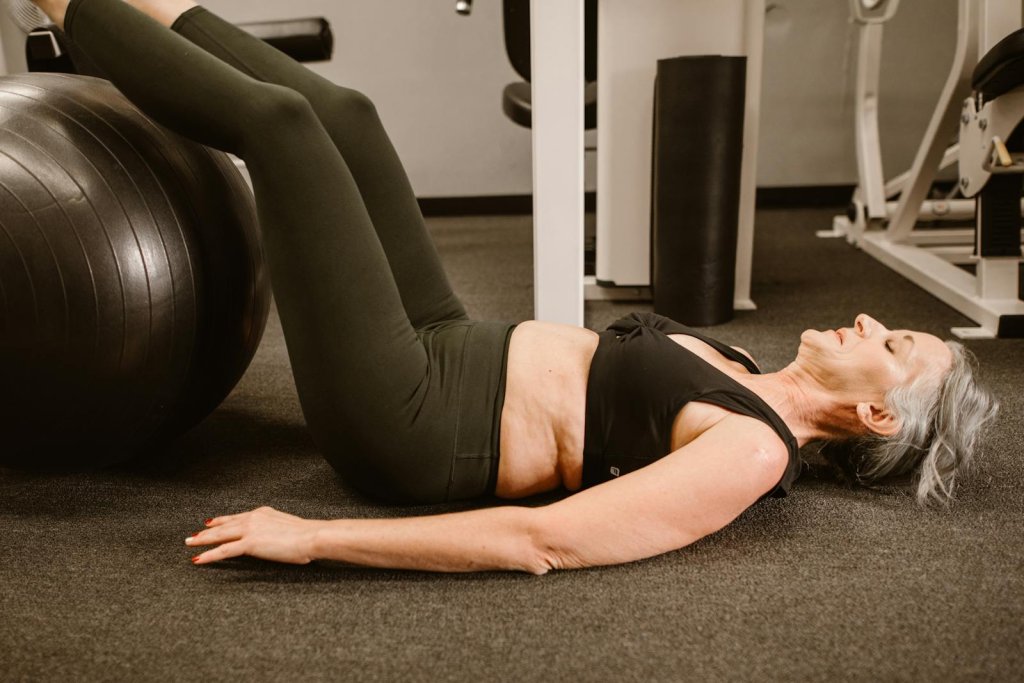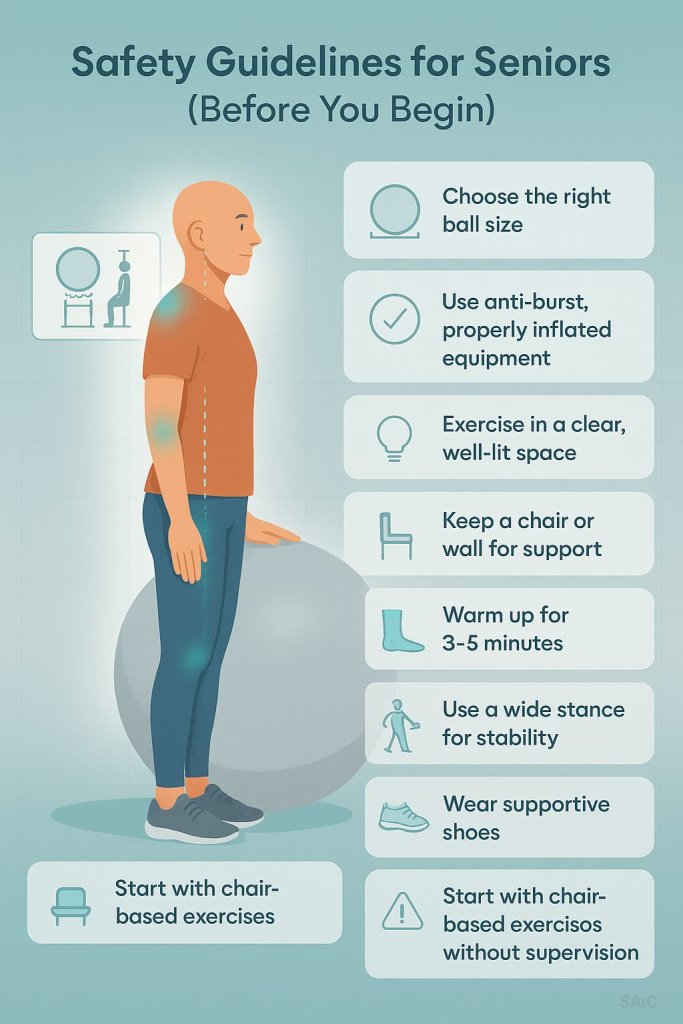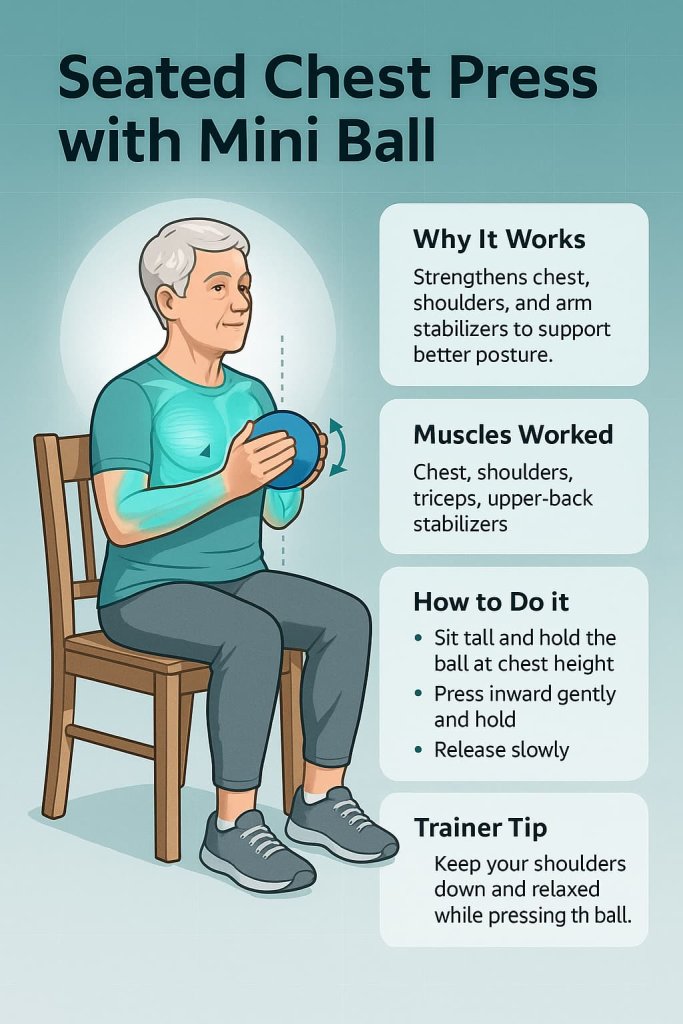Ball exercises for seniors are simple, low-impact movements using a stability ball or small therapy ball to improve balance, strength, and mobility. These exercises are especially helpful because they support safer movement, better posture, and stronger core stability—key factors for healthy aging.

Understanding ball exercises matters because they combine strength, mobility, and balance in one gentle routine. Seniors can perform them seated, standing, or with support, making them suitable for all fitness levels.
In this guide, you’ll learn 12 safe and effective ball exercises, recommended equipment, benefits, safety tips, and answers to common questions.
Why Ball Exercises Matter for Seniors
Ball exercises are valuable for seniors because they improve balance, strength, posture, and mobility in a safe, low-impact way.

Why they matter:
- Provide a gentle form of strength training without heavy weights.
- Activate deep core and stabilizing muscles that support safe walking.
- Improve posture by strengthening the back, shoulders, and chest.
- Enhance balance and body awareness to support fall prevention programs.
- Promote hip and leg strength needed for standing, rising from chairs, and daily tasks.
- Offer flexible options: can be done seated, standing, or with wall support.
- Allow seniors of all fitness levels to progress gradually and safely.
- Support joint-friendly movement, making them suitable for sensitive knees, hips, or back.
Safety Guidelines for Seniors (Before You Begin)
Before starting ball exercises, follow these safety steps to protect your joints, balance, and overall well-being.

Key safety guidelines:
- Choose the correct ball size so your hips sit level or slightly above your knees.
- Ensure the ball is properly inflated and made from anti-burst material.
- Start in a clear space with good lighting and firm flooring.
- Keep a sturdy support nearby (chair, wall, countertop) for balance if needed.
- Warm up for 3–5 minutes with gentle movements (marching, arm circles, shoulder rolls).
- Move slowly and avoid sudden or bouncing motions.
- Keep your feet wider apart when first sitting on a stability ball for added stability.
- Wear supportive shoes with good grip.
- Begin with chair-based exercises if you have limited mobility or balance concerns.
- Never kneel on the ball or attempt advanced balancing movements without supervision.
12 Easy Ball Exercises for Seniors
These simple, low-impact ball exercises help seniors improve balance, strength, and mobility at any fitness level. Each move is gentle, joint-friendly, and designed to support safer everyday movement.
Chair-Based Ball Exercises (Safe for All Levels)
1. Seated Ball Squeezes (Mini Ball)
Why it works:
This gentle squeezing motion strengthens the inner thighs and pelvic floor, which are essential for stability during standing, walking, and getting up from a chair. It also helps improve hip alignment and reduces knee collapse during daily movement.
Muscles worked:
Inner thighs (adductors), pelvic floor, hip stabilizers.
How to do it:
- Sit tall on a sturdy chair with feet flat.
- Place a mini ball between your knees.
- Gently squeeze the ball for 2–3 seconds.
- Release slowly without letting the ball drop.
- Repeat 10–15 reps.
Trainer Tip:
Keep your chest lifted and avoid rounding the back. Focus on slow, controlled squeezing for best activation.
2. Seated Chest Press with Mini Ball
Why it works:
Pressing the ball activates the chest muscles, arms, and upper-body stabilizers. It improves posture by strengthening the muscles that support the ribcage and shoulder alignment.
Muscles worked:
Chest, shoulders, triceps, upper-back stabilizers.

How to do it:
- Sit tall with the ball held between your palms at chest height.
- Press inward gently while keeping elbows lifted.
- Hold 1–2 seconds, then release.
- Repeat 10–12 reps.
Trainer Tip:
Don’t shrug your shoulders. Keep them relaxed and down to reinforce good posture.
3. Seated Overhead Ball Raise
Why it works:
Lifting the ball overhead strengthens the shoulders and deep core muscles while improving mobility in the upper back and ribcage.
Muscles worked:
Shoulders, upper back, core, posture stabilizers.
How to do it:
- Hold the ball in both hands.
- Lift it overhead with straight arms.
- Lower slowly back to chest level.
- Repeat 8–12 reps.
Trainer Tip:
Keep your ribs down and avoid leaning backward. If shoulder mobility is limited, lift only as high as comfortable.
4. Seated Trunk Rotation with Ball
Why it works:
Rotating the torso improves spinal mobility and strengthens the waist muscles. This supports twisting movements needed for daily activities like reaching, turning, and looking behind.
Muscles worked:
Obliques, deep core, spinal stabilizers.
How to do it:
- Hold the ball at chest level.
- Rotate your torso right, then left, without moving your hips.
- Move slowly with control.
- Repeat 8–10 reps per side.
Trainer Tip:
Imagine turning from your ribcage, not your arms. Keep your spine tall and avoid slumping.
Stability Ball Exercises (Beginner to Intermediate)
5. Seated Marches on Stability Ball
Why it works:
Marching on the ball challenges your balance and strengthens the hip muscles that help with walking. The ball’s instability activates deep core muscles.
Muscles worked:
Hip flexors, core, glutes, trunk stabilizers.
How to do it:
- Sit tall on the ball with feet flat.
- Lift one knee to hip height.
- Lower it and lift the other knee.
- Perform 20 alternating marches.
Trainer Tip:
Place the ball near a wall or chair at first. Lift knees slowly to avoid wobbling.
6. Seated Weight Shifts
Why it works:
Side-to-side weight transfers teach your core to stabilize your body as the ball moves. This improves balance confidence and reduces fall risk.
Muscles worked:
Obliques, deep core stabilizers, hip stabilizers.
How to do it:
- Sit on the ball with feet wider than hip-width.
- Shift weight gently to the right, then back to the center.
- Shift left, then center again.
- Repeat 10–12 times.
Trainer Tip:
Keep your shoulders level. Avoid leaning—focus on shifting your weight through your hips.
7. Seated Arm Lifts
Why it works:
Lifting the arms forces the core to work harder to keep the body stable. This improves posture and shoulder strength at the same time.
Muscles worked:
Shoulder stabilizers, core, upper back.
How to do it:
- Sit tall with arms at your sides.
- Lift one arm overhead while keeping torso still.
- Lower and switch sides.
- Perform 10 reps per arm.
Trainer Tip:
If the ball feels too unstable, move your feet wider or perform the exercise near a wall.
8. Pelvic Tilts on the Ball
Why it works:
This gentle movement increases mobility in the lower back and pelvis. It strengthens core control and improves posture—great for relieving stiffness from sitting.
Muscles worked:
Lower abdominals, spinal stabilizers, pelvic muscles.
How to do it:
- Sit near the front of the ball.
- Tilt pelvis forward (arch gently).
- Tilt pelvis back (flatten gently).
- Move slowly for 10–15 reps.
Trainer Tip:
Small movements are more effective than big ones. Think of rocking your pelvis, not moving your entire torso.
Standing or Wall-Supported Ball Exercises (For Better Mobility & Strength)
9. Wall Squats with Stability Ball
Why it works:
The ball provides support for safe squatting, making it easier on the knees and lower back. This strengthens the major leg muscles needed for walking, climbing stairs, and sitting or standing.
Muscles worked:
Quadriceps, glutes, hamstrings, core.
How to do it:
- Place the ball between your mid-back and the wall.
- Step feet slightly forward.
- Lower into a small squat.
- Press through your heels to stand.
- Perform 8–12 reps.
Trainer Tip:
Keep movements small if you have knee sensitivity. The ball should glide smoothly along the wall.
10. Wall Chest Stretch with Ball
Why it works:
This stretch opens the chest and front shoulders, improving posture and reducing tightness from sitting.
Muscles worked:
Chest (pectorals), front shoulders, upper-body fascia.
How to do it:
- Stand beside a wall.
- Place the small ball under your palm.
- Roll your hand outward slightly.
- Hold 10–20 seconds per side.
Trainer Tip:
Keep the shoulder relaxed. This should feel like a gentle opening, not a deep stretch.
11. Standing Ball Circles
Why it works:
Holding the ball out front strengthens the shoulders and upper back while improving control in the arms. The circular motion engages stabilizers that support posture.
Muscles worked:
Shoulders, upper back, arm stabilizers, core.
How to do it:
- Hold the ball at chest height.
- Make small controlled circles clockwise.
- Switch to counterclockwise.
- Continue 10–15 seconds each direction.
Trainer Tip:
Keep elbows slightly bent. Move slowly to avoid shoulder strain.
12. Knee Lifts with Ball Support
Why it works:
Holding the ball for support allows seniors to practice single-leg balance safely. This improves stability, walking strength, and coordination.
Muscles worked:
Hip flexors, core, standing leg stabilizers.

How to do it:
- Hold a stability ball against a wall at chest height.
- Lift one knee up to hip height.
- Hold 2–3 seconds and lower.
- Switch sides for 8–10 reps each.
Trainer Tip:
Keep your standing leg soft (not locked). Focus on slow lifts for better balance control.
How Often Should Seniors Do Ball Exercises?
Most older adults benefit from:
- 2–3 sessions per week
- 10–20 minutes per session
- Combine with walking, light strength training, or stretching
This aligns with major guidelines from CDC, ACSM, and NIA.
Common Mistakes to Avoid
Key mistakes seniors should avoid during ball exercises:
- Using the wrong ball size, which affects posture and stability.
- Moving too quickly or bouncing on the ball instead of using slow, controlled motion.
- Sitting with a rounded back or slumping rather than maintaining tall posture.
- Letting knees collapse inward during wall squats.
- Not using a chair or wall for support when needed.
- Attempting advanced balance positions too early.
- Skipping the warm-up.
- Continuing if you feel pain, dizziness, or unusual discomfort.
Equipment You’ll Need
Most seniors can start with:
- 65 cm stability ball (common size) — typically $20–$35
- Mini 9-inch therapy ball — usually $10–$20
- BOSU balance trainer (optional) — around $140–$200
Choose a ball size where the hips feel level when sitting.
When to Stop and Seek Professional Advice
Stop exercising and consult a healthcare professional if you notice unsafe or unusual symptoms.
Stop immediately if you experience:
- Dizziness, lightheadedness, or loss of balance.
- Sharp or sudden pain in any joint or muscle.
- Chest discomfort or unusual shortness of breath.
- Weakness, numbness, or tingling that feels abnormal.
- Inability to control or stabilize the ball during the exercise.
Seek professional guidance if:
- You have a history of falls or fear of falling.
- You recently had surgery or have ongoing medical conditions.
- You have osteoporosis with increased fracture risk.
- Your mobility or stability has declined recently.
- You’re unsure whether your exercise form is correct.
- You want to progress to more advanced standing or balance exercises safely.
FAQs About Ball Exercises for Seniors
1. Are ball exercises safe for seniors with limited mobility?
Yes. Start with chair-based ball exercises and progress slowly. Always use support when needed.
2. What size ball should a senior use?
Most adults benefit from a 55–65 cm stability ball depending on height. When sitting, thighs should be level.
3. How often should seniors do ball exercises?
Two to three times per week is ideal for balance and strength improvements.
4. Can ball exercises help reduce fall risk?
They may help by improving balance, core strength, and stability—especially when combined with walking and strength training.
5. Should seniors avoid any ball exercises?
Avoid fast bouncing, unstable kneeling, or advanced BOSU drills unless supervised.
6. Is a mini ball necessary?
No, but it helps with gentle squeezing, posture work, and stability exercises.
7. Can beginners start with a stability ball?
Yes—begin seated with feet wider, or start with a chair for support.
Conclusion
Ball exercises are a simple, safe, and highly effective way for seniors to improve balance, strength, and mobility. Whether performed in a chair, on a stability ball, or standing with support, these movements promote better posture, safer walking, and greater independence.
Start with 3–4 exercises, progress slowly, and stay consistent for the best results.
This content is for informational purposes only and not medical advice.
References
- CDC — Physical Activity Guidelines for Older Adults
https://www.cdc.gov/physicalactivity/basics/older_adults/index.htm - U.S. Department of Health and Human Services — Physical Activity Guidelines for Americans, 2nd Edition
https://health.gov/sites/default/files/2019-09/Physical_Activity_Guidelines_2nd_edition.pdf - American College of Sports Medicine (ACSM) — Exercise and Physical Activity for Older Adults (Position Stand)
https://pubmed.ncbi.nlm.nih.gov/19516148/ - Sherrington et al. — Exercise for Preventing Falls in Older People (Systematic Review & Meta-analysis)
https://pubmed.ncbi.nlm.nih.gov/27707740/ - El-Khoury et al. — Fall Prevention Exercise Programmes in Older Adults (BMJ Meta-analysis)
https://www.bmj.com/content/347/bmj.f6234 - Kim & Yoo — Trunk Stabilization Exercises with a Swiss Ball and Core Muscle Activation
https://www.ncbi.nlm.nih.gov/pmc/articles/PMC4175260/ - Zhong et al. — Effects of Core Training on Balance Performance in Older Adults (Frontiers in Public Health)
https://www.frontiersin.org/journals/public-health/articles/10.3389/fpubh.2025.1661460/full
